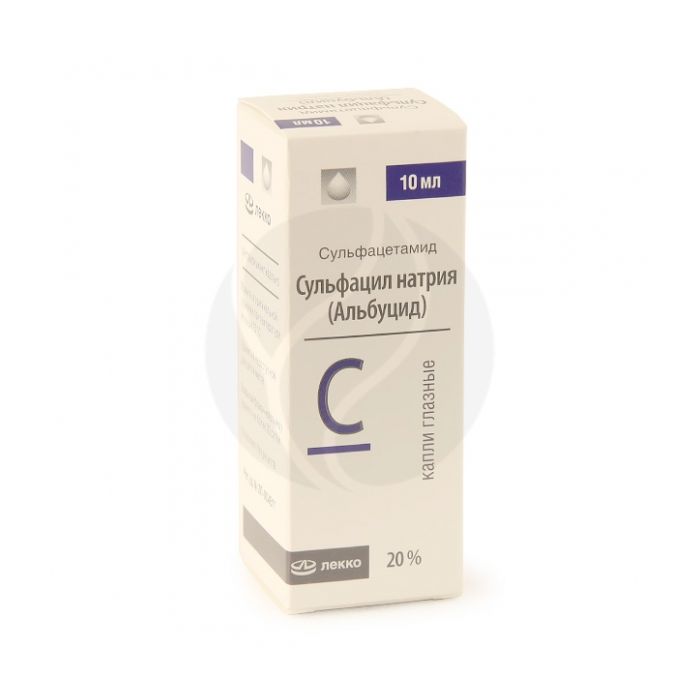Sulfacyl sodium drops 20%, 10ml
Expiration Date: 05/2027
Russian Pharmacy name:
Сульфацил-натрия капли 20%, 10мл
In the complex therapy of diseases of the eyelids, conjunctiva, cornea, anterior segment of the choroid and lacrimal ducts caused by microorganisms sensitive to sulfacetamide.
For the prevention of infectious complications in the complex therapy of burns and eye injuries.
1-2 drops into the conjunctival sac 6-8 times a day (every 2-3 hours). The course of treatment is 7-10 days. The number of instillations can be reduced as the condition improves. When treating diseases of the organs of vision caused by Chlamidia trachomatis, the dosage regimen is 1 drop every 2 hours, the local application of sulfonamide must be combined with systemic therapy. Instilled into the conjunctival sac, 1-2 drops 5-6 times a day.
For the prevention of blenorrhea in newborns - 2 drops in each conjunctival sac immediately after birth and 2 drops after 2 hours.
Composition for 1 ml:
Active substance:
Sulfacetamide sodium monohydrate - 200.00 mg
Excipients: Sodium thiosulfate pentahydrate - 1.5 mg Hydrochloric acid solution 1 M - up to pH 7.5-8.5 Purified water - up to 1.0 ml
Individual hypersensitivity to drug components,
children's age (up to 2 months).
Pharmacological properties
Pharmacodynamics
Antimicrobial bacteriostatic agent, sulfonamide. The mechanism of action is associated with competitive antagonism with PABA and inhibition of dihydropteroate synthetase, which leads to a disruption in the synthesis of dihydrofolic acid and, ultimately, its active metabolite tetrahydrofolic acid, which is necessary for the synthesis of purines and pyrimidines.
Active against gram-positive and gram-negative cocci, Escherichia coli, Shigella spp., Vibrio cholerae, Clostridium perfringens, Bacillus antracis, —orynebacterium diphteriae, Yersinia perstis, Chlamydia spp., Actinomyces israelii, Toxoplasma gels.
Development of resistance to sulfacetamide is possible.
Pharmacokinetics
Penetrates into the tissues of the eye, where it has its specific antibacterial effect. It works mainly locally, but part of the drug is absorbed through the inflamed conjunctiva and enters the systemic circulation. The amount of the drug entering the systemic circulation is insufficient for the development of a systemic therapeutic effect, but sufficient for sensitization upon repeated administration.
When applied topically, the maximum concentration (C max) of sulfonamides in the cornea (about 3 mg / ml), the moisture of the anterior chamber (about 0.5 mg / ml) and the iris (about 0.1 mg / ml) is achieved in the first 30 minutes after application ... A certain amount (less than 0.5 mg / ml) remains in the tissues of the eyeball for 3-4 hours. When the corneal epithelium is damaged, the penetration of sulfonamides increases. Sulfacetamide is metabolized in the liver by N-acetylation, the metabolites have antibacterial activity. Excretion occurs by glomerular filtration.
Application during pregnancy and during breastfeeding
Sufficient experience in use during pregnancy, no breastfeeding.
It is possible to use sulfacetamide for the treatment of pregnant and lactating mothers as directed by the attending physician, if the expected therapeutic effect outweighs the risk of developing possible side effects. Sulfonylamides pass through the placenta and into breast milk.
It is possible to develop kernicterus in newborns whose mothers took tablet forms of sulfonamides during pregnancy, therefore it is impossible to exclude the risk of developing jaundice when taking sulfonamide in the dosage form of eye drops.
Side effect
Burning, lacrimation, pain, itching in the eyes, allergic reactions, transient blurred vision after instillation, nonspecific conjunctivitis, the development of superinfection, severe allergic reactions to sulfonamides (Steven-Johnson syndrome, toxic epidermolysis, fulminant liver necrosis, agranulocytosis). Aplastic anemia.
If any of the side effects indicated in the instructions are aggravated, or if you notice any other side effects not listed in the instructions, inform your doctor.
Overdose
There are no data on drug overdose.
Interaction with other medicinal products
Sulfacetamide enhances the effect of indirect anticoagulants. Combined use with benzocaine, procaine and tetracaine reduces the bacteriostatic effect of sulfacetamide. There is an incompatibility of sulfacetamide when it is used together with silver salts. Concomitant administration with chloramphenicol increases the risk of side effects of the latter. Diphenin, para-aminosalicylic acid (PAS), salicylates increase the toxicity of sulfacetamide.
special instructions
Patients with hypersensitivity to furosemide, thiazide diuretics, sulfonylurea derivatives, or carbonic anhydrase inhibitors may be hypersensitive to sulfacetamide.
Excessive growth of microorganisms insensitive to sulfonamide, as well as fungal flora, is possible.
Decrease in antibacterial activity in the presence of high concentrations of para-aminobenzoic acid in the presence of a large amount of purulent discharge.
It is necessary to stop therapy if symptoms of allergy appear, as well as with increased pain and other signs of an infectious process, an increase in purulent discharge.
Influence on the ability to drive vehicles, mechanisms
In the case of development of blurred vision after instillation, it is necessary to refrain from driving vehicles and engaging in potentially hazardous activities that require increased concentration of attention and speed of psychomotor reactions until the clarity of vision is restored.

